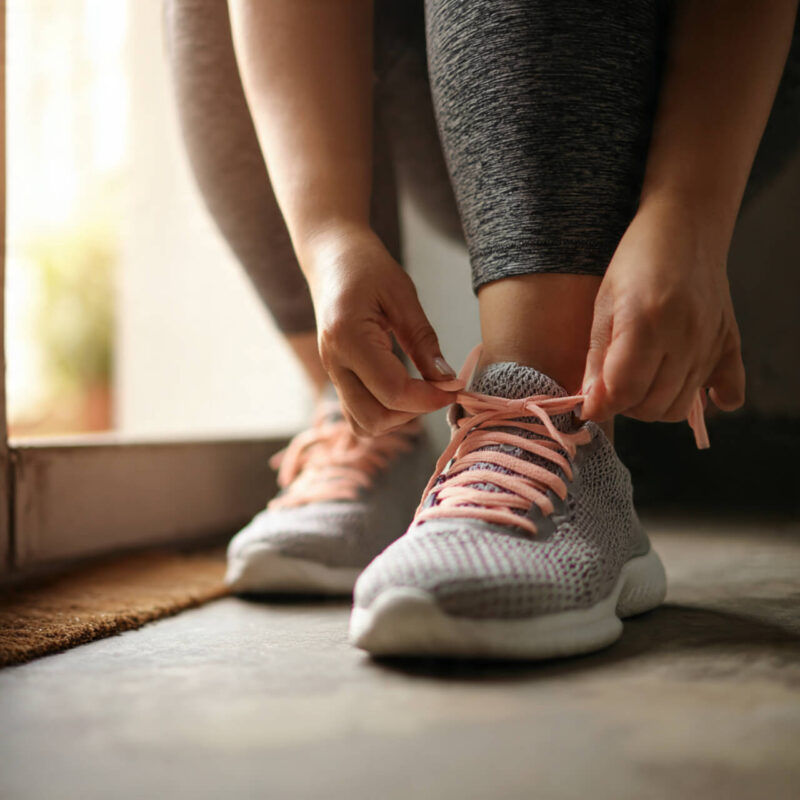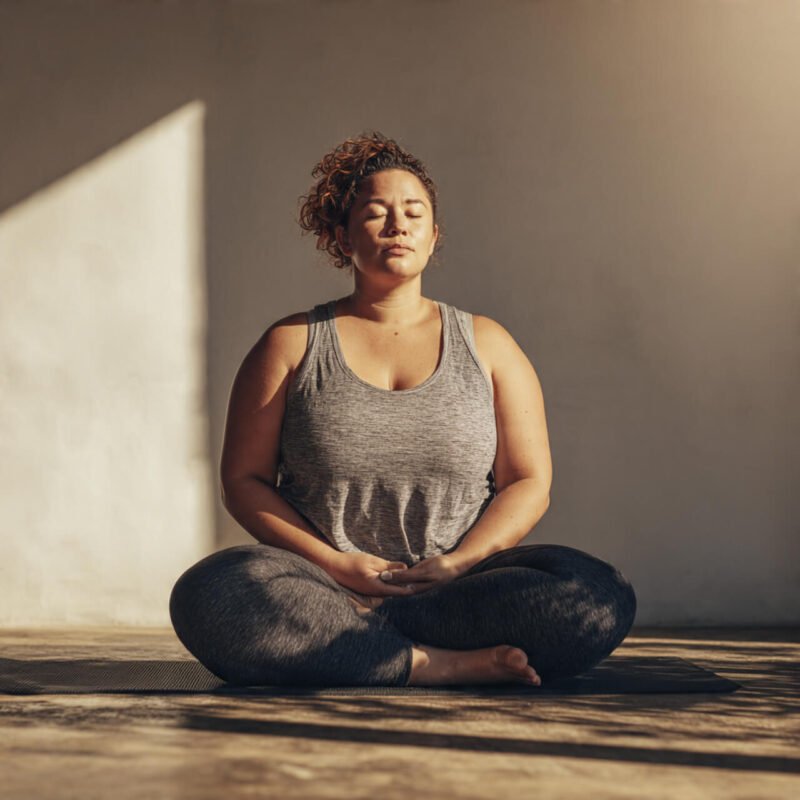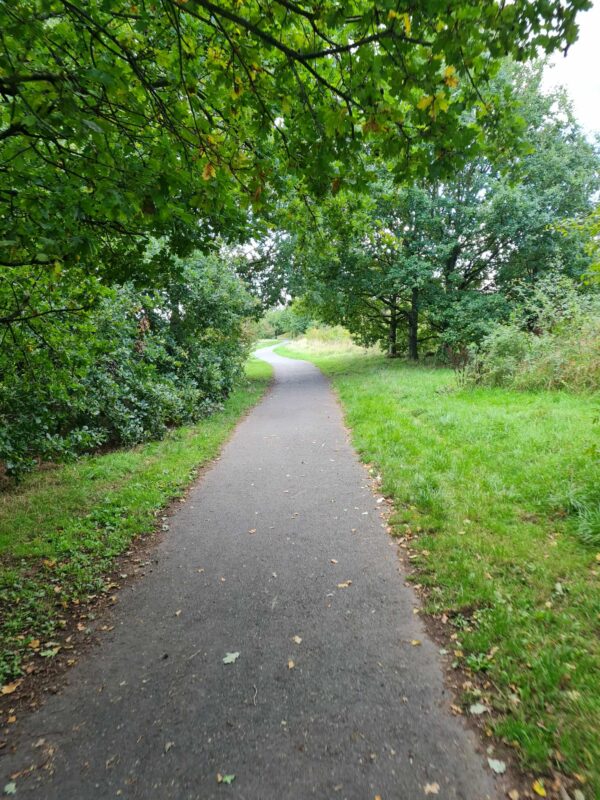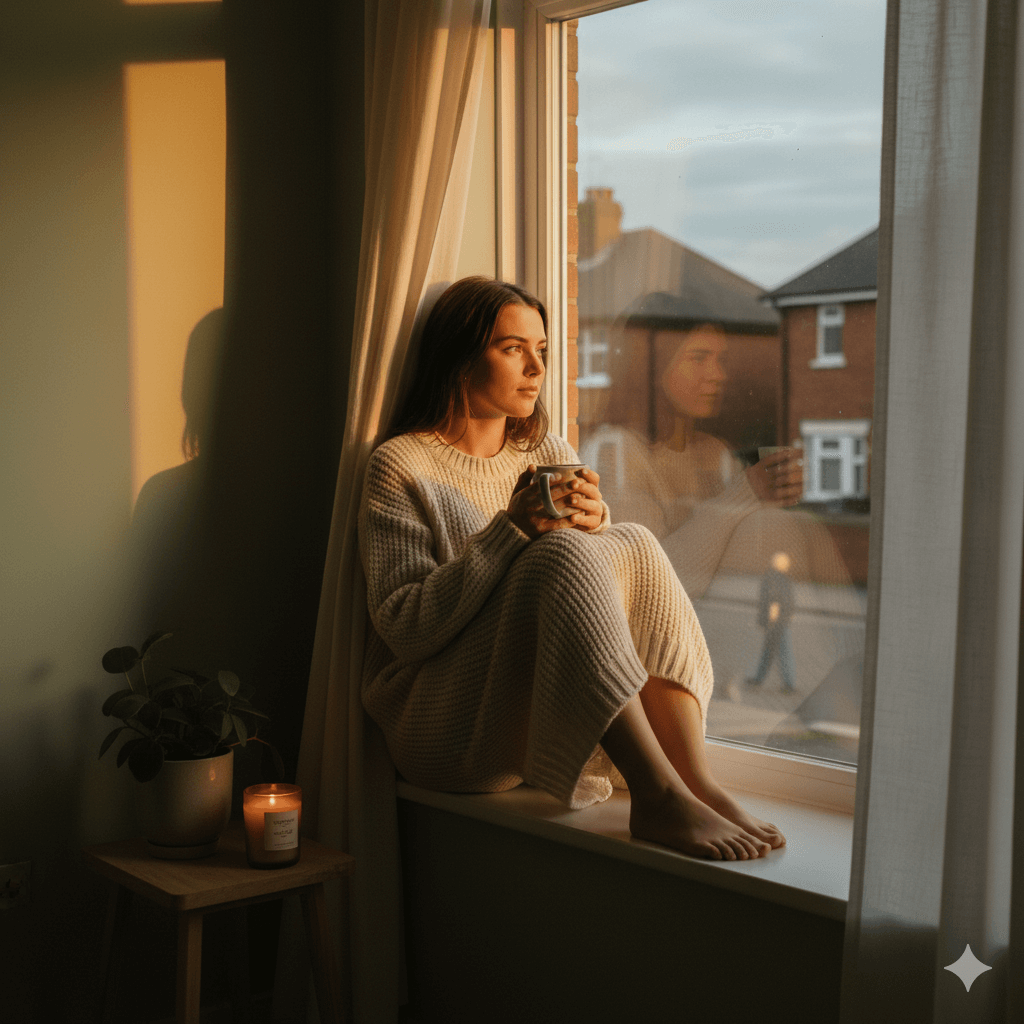Read time: 14 minutes
Quick Summary:
Starting to exercise when you’re overweight can feel intimidating but it doesn’t have to. This guide shows how to start exercising when overweight through small, shame-free steps that rebuild your confidence and consistency.
You know that feeling when you try to bring your knees to your chest and there’s this massive chunk of flesh in the way? When you’re following along with an instructor who makes it look effortless, and your body just… won’t? That moment when you think, “This is never going away.”
I know that feeling. And I’m here to tell you it’s lying.
The hardest part isn’t sweating, it’s the voice in your head whispering that you’ll always look like this. That you’ve failed too many times to try again. That you’re the “before” picture that never gets to be “after.” That quiet despair is heavier than the weight itself.
Why Is It So Hard to Start Exercising When You’re Overweight?
The barrier isn’t physical—it’s psychological. Exercise isn’t punishment for the body you have. It’s not penance. It’s an investment in the body you’re building. That single shift in perspective—from shame to self-respect—changes everything.
Most fitness content assumes you already believe you belong in fitness spaces. But when you’re overweight, every movement feels like a reminder of what your body can’t do. The real challenge when you start exercising isn’t finding the perfect workout—it’s giving yourself permission to start imperfectly.
For more on building systems that grow naturally from small wins, read How to Build Lasting Habits with Habit Stacking.
Disclaimer: I’m a coach, not a clinician. What I share comes from real practice and personal experience, not medical advice. If you’re finding exercise difficult or painful, please check in with your GP or a physiotherapist—support helps.

- What Are the First Steps to Start Exercising When Overweight?
- What Does Common Fitness Jargon Actually Mean?
- What's the Best Beginner Exercise if I'm Overweight?
- How Do I Exercise Without a Gym or Personal Trainer?
- How Can I Stay Consistent When Motivation Disappears?
- What Do I Do When I Fall Off My Fitness Routine?
- 3 Actions You Can Take Today
- Everyday Mastery Steps You Can Take Now
- How Do I Deal With Feeling Embarrassed or Ashamed While Exercising?
- How Long Before I See Results?
- Frequently Asked Questions
- Journaling Prompts
What Are the First Steps to Start Exercising When Overweight?
Start with something so small it feels almost embarrassing. Forget hour-long gym sessions or intense boot camps.
Twice-a-week yoga sessions where the app chirps “brace your core” and you think, “What the hell is a core?” That’s a start. Lying on your mat, feet miles away from your hands, knowing there’s zero chance of touching your toes. That’s still a start. Following along even though you can’t do the rolls because your knees won’t reach your chest.
That’s exactly where you’re supposed to begin.
I remember one session, finally managing to pull my knees toward my chest, and feeling the weight of my stomach pressing back against my thighs. The disgust hit me like a wave. But here’s what I didn’t know then: showing up despite that feeling was the entire point. That was the work.

Mr Critic Moment:
“You look ridiculous. Everyone else can do this. Maybe you should just stop embarrassing yourself.”
That voice? It’s not truth, its your brain trying to keep you safe from discomfort. It’s resistance dressed as logic. You don’t have to silence it—you just have to keep moving while it talks.
Not everyone experiences an inner critic as a voice. Some feel it as tension in the chest, a heavy gut, or that familiar urge to give up. However it shows up, the work is the same: recognise it, breathe, and move anyway.
What Does Common Fitness Jargon Actually Mean?
“Brace your core.” “Engage your glutes.” “Neutral spine.”
What does any of that actually mean when you’re lying on a mat trying to follow along?
“Brace your core” = Tighten your stomach muscles like you’re about to cough or like someone’s about to poke you in the belly. That’s it. That’s your core.
“Engage your glutes” = Squeeze your bum. Seriously. Just clench your butt muscles.
“Neutral spine” = Don’t arch your back dramatically or flatten it completely. Imagine there’s a small space under your lower back—about the size of your hand.
Fitness instructors toss these phrases around like everyone already knows them. They don’t explain because they forgot what it’s like to be a complete beginner. You’re not stupid for not knowing. You just haven’t been taught yet.
When an exercise feels impossible, it’s often because your body can’t get into that position yet and that’s fine don’t worry about it. Can’t touch your toes? Reach for your shins instead. Can’t do a full push-up? Do them against a wall or on your knees. Can’t hold a plank? Hold it for five seconds instead of thirty.
Every exercise has a modification. You’re not failing the exercise you’re just doing your version of it until you can do their version if you wish to do so. No-ones exercises are the the right ones.

What’s the Best Beginner Exercise if I’m Overweight?
There isn’t one “best” exercise. The best exercise is the one you’ll actually do. Here’s what works for different needs:
If high-impact movement feels uncomfortable: Maybe you try HIIT workouts and realize that no amount of willpower is going to make you comfortable jumping around with everything wobbling. That’s not failure, that’s some information that you probably wont be able to sustain that.
Maybe that’s when you discover weight training. Not bodybuilding intensity, just simple strength work that makes you feel solid instead of jiggly. Controlled movements where nothing bounces. Exercises that build the foundation to carry you through old age.
If you want something free and accessible: Start walking. Not 10,000 steps on day one—just 100 more steps than yesterday. That’s it. Walk to the end of the driveway and back. Around the block once. Gradually add more when it feels manageable. 2,000 becomes 3,000. Months later, maybe it’s 10K. Maybe it’s not. Either way, you’re moving.
For motivation, check out The Real Benefits of Walking for Everyday Energy.
I also use GetfitwithRick on Youtube for when the weathers bad or I just want to mix it up.
If you have a lot of weight to lose and even walking feels difficult: Sit in a chair and do small arm movements with light weights—even soup cans work. Leg stretches while sitting. Ankle circles. Arm raises. Movement is movement, regardless of whether you’re standing or sitting.
For joint-friendly options: Swimming, water aerobics, chair yoga, or cycling put less stress on your knees, hips, and back while still providing effective exercise.
How Do I Exercise Without a Gym or Personal Trainer?
You don’t need permission from the fitness industry. No gym required, or personal trainer and no expensive equipment. The best workout is the one you’ll actually do.
If that’s yoga in your bedroom at 6 AM in your pajamas, perfect. It could be strength training in your living room with dumbbells from the charity shop, excellent. Maybe it’s walking around your neighbourhood while listening to podcasts, brilliant.
Home workouts are completely valid. YouTube has thousands of free beginner-friendly videos. Apps like Nike Training Club offer guided sessions. You can build genuine fitness without ever setting foot in a gym.

How Can I Stay Consistent When Motivation Disappears?
Motivation is a liar. It shows up when you’re excited and vanishes when you’re tired. Habits persist.
Pick something small enough that even on your worst day, you can still do it. Schedule it like a doctor’s appointment—non-negotiable, even if it’s just 10 minutes. No motivation for 20 minutes today? Do 10 and put some effort into it. That’s not failure, that’s still showing up.
And when it vanishes — because it will — the guilt creeps in. You tell yourself you’ve ruined your streak, that you’ll “start fresh Monday,” but Monday never comes.
That’s the trap. The fix is smaller goals. Ten minutes counts. It always has.
Consistency beats intensity every time. Three 15-minute sessions you actually do trump five imaginary 60-minute workouts.
Track your progress in ways that aren’t scale-dependent: you walked further without getting winded, you held a plank for five extra seconds, you didn’t skip your workout even though you wanted to. These victories matter more than the number on the scale.
For a deeper mindset shift, read How to Overcome Perfectionism. It pairs perfectly with rebuilding confidence through small wins.
What Do I Do When I Fall Off My Fitness Routine?
You will miss workouts. You’ll have a week where you don’t exercise at all. Maybe two weeks. Maybe a month.
When that happens, shame whispers that you’ve failed — that all your progress is gone. That’s the lie that keeps most people stuck.
Here’s the truth: restarting is progress.
Here’s what you don’t do: punish yourself. Don’t think “I missed Monday so I need to do two sessions today to make up for it.” That’s how you burn out and quit entirely.
Here’s what you do instead: start again. Not tomorrow—today. Just pick up where you left off. No punishment. One session. That’s it. The gap doesn’t matter. What matters is that you came back.
There’s no streak to maintain, no perfect record to uphold. There’s just you, showing up again, choosing to keep going. That’s the whole game.
3 Actions You Can Take Today
- Do ten arm raises while sitting down—movement counts, no matter the form.
- Walk to the end of your street and back. That’s a workout.
- Watch one beginner YouTube video and try the first move only. Just one.
Everyday Mastery Steps You Can Take Now
- Notice how your body feels after moving, not how it looks. That awareness builds trust.
- Try replacing the word “exercise” with “movement.” It removes pressure and restores curiosity.
- Remember: restarting is progress. Every comeback is a muscle in itself.
If you’re adjusting food choices alongside movement, explore 7 Food Swaps for When You’re Tired All the Time to support your new energy levels.
How Do I Deal With Feeling Embarrassed or Ashamed While Exercising?
You will have moments when progress feels impossible. When your body won’t cooperate. When you catch your reflection and feel that familiar disgust wash over you.
That sting makes you want to disappear, to quit before anyone sees you trying. But showing up while you feel that is the entire point. That’s how change begins.
Those moments don’t disappear—you just learn to keep moving through them. Every person who transformed their fitness has had those moments. The difference isn’t that successful people never feel discouraged. It’s that they show up the next day anyway.
Your body will change. Not overnight. But one morning you’ll reach for your toes and realize your fingers got an inch closer. You’ll bring your knees to your chest and that chunk of fat will be smaller. You’ll catch yourself walking without getting winded.
Small victories. They add up.
To pair mindset with environment, read 5 Simple Ways to Achieve Weight Loss Without Willpower.
What Should I Focus On—Appearance or Capability?
Your body can show up for a session. It can complete one more rep than last week. It can walk further today than last month. Every time you exercise, you’re proving to yourself that you’re capable.
Focus on what your body can do, not what it looks like. Can you climb stairs without getting winded? or carry shopping bags without your arms aching? Can you play with your kids or grandkids without needing a break?
These functional improvements matter more than fitting into smaller jeans. Though that often comes too, eventually.
How Long Before I See Results?
The road is tough. But small steps don’t overwhelm you. You just keep moving forward until one day you will look back and realize how far you’ve travelled.
Don’t wait until you feel ready. Just begin right where you are, with whatever you can manage today. Please don’t get an obsession with scales either , take pics and measurements and check in every few months or so.
That’s enough.
UK Everyday Example
If you’re in the UK, skip the all-or-nothing gym pressure and start local. Lace up your trainers and take a ten-minute walk—yes, even if it’s raining. The NHS Get active your way guide has free ideas and beginner tips that actually work for real life.

Frequently Asked Questions
How much exercise should I do if I’m overweight and just starting?
Start with 10-15 minutes, 2-3 times per week. That’s genuinely enough. You can increase gradually as it gets easier. Doing something small consistently beats doing something ambitious once.
Can I lose weight just by walking?
Yes. Walking burns calories, improves cardiovascular health, and is sustainable long-term. Start with whatever distance feels manageable and build from there. Pair it with mindful eating for best results.
What if I’m too embarrassed to exercise in public or at a gym?
Exercise at home. YouTube has thousands of free beginner workouts. You can walk early morning or late evening when fewer people are around. Your fitness journey doesn’t require an audience.
Will exercise hurt my knees if I’m overweight?
High-impact exercises like running can stress your joints. Stick to low-impact options: walking, swimming, cycling, chair exercises, or strength training. Research consistently shows that strengthening exercises can actually reduce joint pain by strengthening the muscles surrounding your joints, even for people carrying extra weight. These build fitness while protecting your knees.
How long before I see results from exercising?
You’ll feel results before you see them. Better energy, improved mood, and easier daily movement often show up within 2-3 weeks. Physical changes take longer—typically 6-8 weeks—but they will come.
What’s better for weight loss: diet or exercise?
Both matter, but you can’t out-exercise a poor diet. Start with whichever feels more manageable. Many people find that starting with small exercise habits naturally leads to better food choices.
Do I need equipment to work out at home?
No. Bodyweight exercises, chair workouts, and walking require zero equipment. When you’re ready, cheap dumbbells or resistance bands add variety, but they’re not necessary to start.
Journaling Prompts

Journaling Prompts:
What does “movement” mean to you right now—how has that changed from before?
What sensations or emotions show up when you move your body? Where do you feel them?
What’s one tiny way you can show self-respect through movement this week?
This is your permission slip to start messy.
We don’t chase perfect here — we practise progress. That’s everyday Mastery
If this helped you start exercising when overweight with a little more kindness, you can buy me a coffee — it keeps the kettle (and the ideas) warm.
If you’re beginning to start exercising when overweight and want gentle motivation each week, join the Everyday Mastery newsletter small steps, steady wins.
Kel is the writer behind Everyday Mastery, where she shares the real, messy, and meaningful process of building habits, resilience, and self-belief from the ground up. Her writing blends ancient philosophy with modern science, always focused on small, practical steps that lead to lasting





